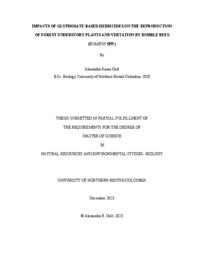Golt, Alexandra
Person Preferred Name
Alexandra Golt
Related Works
Content type
Digital Document
Description / Synopsis
Glyphosate is the active ingredient in many common broad-spectrum herbicides used in forestry operations to reduce the presence of unwanted, competitive plant species. As a result of aerial applications, non-target forest understory plants receive a sublethal dose of glyphosate-based herbicides (GBH) and develop abnormalities such as changes in reproductive morphology. Glyphosate inhibits the enzyme 5-enolpyruvylshikimate-3-phosphate synthase (EPSPS) of the shikimate pathway which produces the crucial aromatic amino acids for plant growth and other biochemical processes. There is very limited information on the long-term impacts of GBH on forest understory plant reproduction, fruit production, and vegetation production. Additionally, there are limited resources that discuss the impacts of GBH on the detection and visitation by bumble bees (Bombus spp.). The objectives of this research were to: 1) quantify glyphosate residues present in Chamaenerion angustifolium flowers and in samples of Bombus spp. found in areas treated with GBH; 2) quantify and compare stamen fluorescence of C. angustifolium (fireweed) flowers from GBH treated and untreated areas in operational forestry settings; 3) quantify the abundance and occurrence of different Bombus spp. in cutblocks one- and two-years post application compared to control sites; 4) quantify and compare the visitation of C. angustifolium by Bombus spp. in glyphosate-based herbicides treated and untreated plants; and 5) quantify and compare pollen viability, leaf-out, and fruit production in a variety of important food-producing forest plants in glyphosate-based herbicide treated and untreated sites in operational settings. I found that the amount of glyphosate residue present in floral tissues remained similar between one- and two-years post treatment. I also found that glyphosate-based herbicides have an impact on the fluorescence of male reproductive structures of forest understory plants. There was a reduction in the fluorescence emission of blue spectral wavelengths of anthers and pollen due to glyphosate-based herbicide treatment could lead to a reduction in detection and visitation by bumble bees as the blue photoreceptor in their compound eyes will be less likely to detect a flower for the bee to be drawn to it. Additionally, the increase in hue and saturation indicates that the presentation of the dominant wavelength present may no longer be the blue spectral wavelength. My findings indicate that glyphosate-based herbicides do not have an impact on the amount of time an individual bumble bee spends foraging on a flower. Glyphosate treatment influences floral characteristics related to bumble bee detection of flowers during foraging. This affects the number of bees present, but glyphosate-based herbicides do not impact how long an individual bumble bee visits a flower nor foraging effort once they are on a flower. The reduction in pollen viability seen in C. angustifolium one-year post-application is similar to pollen viability seen in control samples by year two after glyphosate-based herbicide applications, indicating that GBH initially have a large impact on pollen quality but there is a recovery in pollen quality in C. angustifolium over time. Lastly, my findings indicate that application of GBH resulted in a reduction of leafout and fruit production of multiple forest plants one-year post-glyphosate treatment. The reality is that GBH may have greater implications on the ecological roles of fruit-producing plants and for the availability of food for animals in forest cutblocks than was previously acknowledged.
Origin Information

